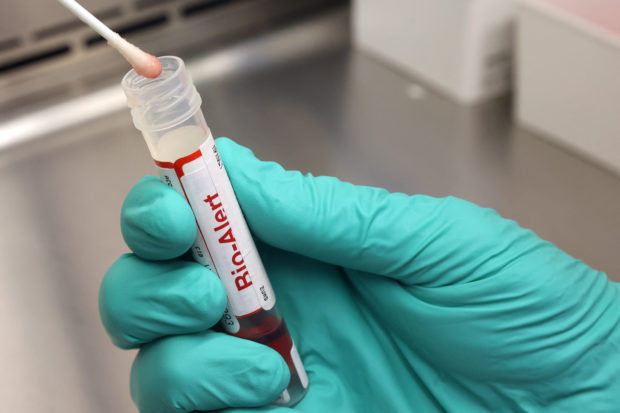Monkeypox: how a public emergency could be declared

A swab that tested positive for the Monkeypox virus is seen at the UW Medicine Virology Laboratory at the UW Medicine Virology Laboratory on July 12, 2022 in Seattle, Washington. AFP
GENEVA — The World Health Organization’s expert monkeypox committee will meet on Thursday to decide whether to deploy the UN health agency’s rarely used top alert for the worsening virus outbreak.
The WHO could declare the situation to be a Public Health Emergency of International Concern (PHEIC).
Here is a look at how the decision is made and previous PHEIC declarations:
What is a PHEIC?
The conditions which must be met are set out under the 2005 International Health Regulations (IHR) — the legal framework defining countries’ rights and obligations in handling public health events that could cross borders.
A PHEIC is defined in the regulations as “an extraordinary event which is determined to constitute a public health risk to other states through the international spread of disease and to potentially require a coordinated international response”.
The definition implies that the situation is serious, sudden, unusual or unexpected; carries implications for public health beyond an affected country’s border; and may require immediate international action.
Emergency committee
The WHO’s 16-member emergency committee on monkeypox is chaired by Jean-Marie Okwo-Bele from the Democratic Republic of Congo, who is a former director of the WHO’s Vaccines and Immunisation Department.
The committee brings together virologists, vaccinologists, epidemiologists and experts in the fight against major diseases.
It is co-chaired by Nicola Low, an associate professor of epidemiology and public health medicine from Bern University.
The other 14 members are from institutions in Brazil, Britain, Japan, Morocco, Nigeria, Russia, Senegal, Switzerland, Thailand and the United States.
Eight advisers from Canada, the DRC, South Africa, Sweden, Switzerland and the United States also take part in the meetings.
Decision
The emergency committee will provide WHO chief Tedros Adhanom Ghebreyesus with a PHEIC recommendation, and an assessment of the risk to human health, the risk of international spread and the risk of interference with international traffic.
Tedros will then make the final determination on whether a PHEIC should be declared, based on their advice.
Six previous PHEICS
The WHO has previously declared a PHEIC six times:
— 2009: H1N1 swine flu
The pandemic was first detected in Mexico and then quickly spread across the United States and the rest of the world.
— May 2014: Poliovirus
Declared following a rise in cases of wild polio and circulating vaccine-derived poliovirus. Besides Covid, it is the only PHEIC still in place.
— August 2014: Ebola
Outbreak in western Africa which spread to Europe and the United States.
— February 2016: Zika virus
The epidemic began in Brazil and heavily affected the Americas. The only PHEIC declared over a mosquito-borne virus.
— July 2019: Ebola
The second Ebola PHEIC was over the outbreak in Kivu in eastern DRC.
— January 2020: Covid-19
Declared when — outside of China where the virus first emerged — there were fewer than 100 cases and no deaths.
Covid-19 frustrations
The Covid-19 PHEIC declaration came after a third meeting of the emergency committee on the spreading virus. Meetings on January 22 and 23, 2020 decided that the outbreak did not constitute a PHEIC.
Despite the declaration, it was only after March 11, when Tedros described the rapidly worsening situation as a pandemic, that many countries seemed to wake up to the danger.
The sluggish global response still rankles at the WHO’s headquarters and raised questions about whether the PHEIC system under the IHR was fit for purpose.
By March 11, the number of cases outside China had soared, with more than 118,000 people having caught the disease in 114 countries, and 4,291 people having lost their lives, following a jump in deaths in Italy and Iran.
“The warning in January was way more important than the announcement in March,” WHO emergencies director Michael Ryan said on the second anniversary of the pandemic declaration.
“People weren’t listening. We were ringing the bell and people weren’t acting.
“Do you want the warning to say you’ve just drowned, or would you like the warning to say the flood is coming?”
RELATED STORIES
Experts: No need to be scared of monkeypox
WHO to decide on sounding highest alarm on monkeypox
Factbox: Monkeypox cases around the world